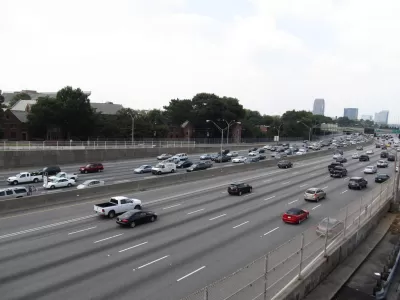Despite evidence that widening roadways is only a temporary solution to congestion, a decades-long inertia leads states to continue pushing expansion projects against local opposition.

By now, the phenomenon of induced demand forms a common refrain among transportation planners: "adding lanes won’t cure snarled traffic; the additional car space inevitably invites more trips, until gridlock is as bad as ever." But, as David Zipper writes, despite repeated evidence that widening roads only leads to more traffic, agencies like the Texas Department of Transportation continue to plow ahead with expansion plans. In Austin, TxDOT has plans to widen Interstate 35, already a behemoth at twelve lanes.
The "iron law of congestion," as induced demand is otherwise known, "applies not only to U.S. cities, which have grown more traffic-jammed despite billions of dollars in fresh pavement, but also to those around the world." Zipper wonders, then, why it has been such an uphill battle for "for officials to recognize the futility of urban roadway expansion." Zipper posits that highway planners "are operating within a political and financial system that rewards new construction, despite its consistent failures to reduce congestion," leading agencies to "continue repeating the same predictable, costly mistakes."
Urban street widening began in earnest in the 1920s, as automobiles became more available and traffic began to choke American city streets. Yet as far back as 1927, "an engineer named Arthur S. Tuttle warned that the new urban roads 'would be filled immediately by traffic which is now repressed because of congestion.' His prediction held true." The next step for planners was creating expressways aimed at speeding up traffic and avoiding the delay caused by stoplights. This didn't solve the congestion problem either. In addition to the destruction wreaked on Black neighborhoods, expressways "were a failure even by their own standards."
One problem, according to Beth Osborne of Transportation for America, is that "[t]he federal government doesn’t penalize states for getting their congestion mitigation estimates wrong." Meanwhile, "[s]tate DOTs are expanding interstates even in places such as Akron that have seen population declines, in the process fostering spread-out development patterns that require more driving." State DOTs also have an interest in increasing miles traveled, as the gas tax paid by drivers directly funds their departments.
"There are signs that this approach is starting to change — at least in some places," but "turning down a new highway lane remains politically challenging," as the concept of induced demand continues to raise eyebrows among those who haven't studied the evidence and "politically potent contractors, unions and automakers have an incentive to keep the public confused."
To move the needle, "federal officials could provide a nudge — or a shove — to encourage local and state transportation planners to acknowledge induced demand’s reality." In March of this year, the "FHWA halted TxDOT’s I-45 expansion in Houston, a move celebrated by environmental advocates and local officials" that signals a potential shift in federal policy that could encourage state DOTs to rethink widening projects in favor of more effective, sustainable solutions to traffic problems.
FULL STORY: The Unstoppable Appeal of Highway Expansion

Maui's Vacation Rental Debate Turns Ugly
Verbal attacks, misinformation campaigns and fistfights plague a high-stakes debate to convert thousands of vacation rentals into long-term housing.

Planetizen Federal Action Tracker
A weekly monitor of how Trump’s orders and actions are impacting planners and planning in America.

In Urban Planning, AI Prompting Could be the New Design Thinking
Creativity has long been key to great urban design. What if we see AI as our new creative partner?

King County Supportive Housing Program Offers Hope for Unhoused Residents
The county is taking a ‘Housing First’ approach that prioritizes getting people into housing, then offering wraparound supportive services.

Researchers Use AI to Get Clearer Picture of US Housing
Analysts are using artificial intelligence to supercharge their research by allowing them to comb through data faster. Though these AI tools can be error prone, they save time and housing researchers are optimistic about the future.

Making Shared Micromobility More Inclusive
Cities and shared mobility system operators can do more to include people with disabilities in planning and operations, per a new report.
Urban Design for Planners 1: Software Tools
This six-course series explores essential urban design concepts using open source software and equips planners with the tools they need to participate fully in the urban design process.
Planning for Universal Design
Learn the tools for implementing Universal Design in planning regulations.
planning NEXT
Appalachian Highlands Housing Partners
Mpact (founded as Rail~Volution)
City of Camden Redevelopment Agency
City of Astoria
City of Portland
City of Laramie





























